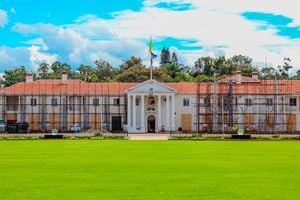New move to make quarries a safe place to work in

Many Kenyans work in quarries to make a living. PHOTO/ CORRESPONDENT
What you need to know:
- People being buried alive as they dig for building materials worries government
Many people toil in quarries to make a living, but occasionally some are buried alive. Every year, big boulders and earth come tumbling down, sending many workers to their graves in an industry that has little by way of safety.
Quarrying is the backbone of the local building construction industry. Recently, substantial deposits of guano, a mineral rich in nitrogen and phosphate, were found in the Mt Elgon caves, which Western provincial geologist Josphat Njogu said could serve as a natural fertiliser.
His department had intensified mineral exploration and geological surveys to identify more deposits, he said, adding that the government is also looking for an investor to carry out commercial harvesting of the mineral and provide an alternative fertiliser for farmers.
But the sector, perceived as a source of livelihood for many communities, has turned into a death trap, and it is not certain that those who get into the deep pits will get out and enjoy the fruits of their labour.
Five buried alive
In February, this year, five people were buried alive after a quarry caved in at the Mukangu village of Murang’a East district.
The incident prompted the minister for the Environment and Mineral Resources, Mr John Michuki, to order the quarry closed and directed permanent secretary Lawrence Lenayapa to set up a task force to conduct an environmental audit of all quarries in Kenya.
A report of the team on the management of quarries, which was produced last month, recommends a raft of measures. The team inspected over 60 sites and concluded that there was no clear regulatory framework for the management of Kenyan quarries, leading to dangerous operations.
It found out that most workers have no protective gear, water or toilets. Work takes place in high vertical cliffs, and risky transport and tunnelling make the sites unsafe.
Several quarries are close to homesteads, schools, roads, rivers, railway lines and shopping centres, and there are complaints of a nuisance and danger posed by uncontrolled and illegal blasting, dust and water ponding in the pits.
The team noted encroachments onto ecologically sensitive areas and the deposition of waste in some waterways.
There is notable land degradation due to inadequate rehabilitation and quarries’ after-use plans.
Workers were found to be exploited by middlemen, leading to low wages despite the industry’ high turnover.
The workers have a limited opportunity to take part in collective bargaining since they have no formal association or trade union.
The task force said that the implementation to the letter of its report would end the untold suffering that has faced communities living around the quarries and the miners themselves.
It proposed that legislative action be followed up by the relevant government agencies, especially the enactment of the Mining and Minerals Bill, which is still awaiting cabinet approval.
The Bill, the report says, should provide a legal framework for quarrying activities for both building stone and sand.
The operators are also urged to ensure the use of protective gear, the application of safe practices, such as benching, and the seeking of authorised blasters’ services
Current procedures of Environmental Impact Assessment and audit certification were also found to be too expensive to the informal operators, making compliance difficult to achieve.
A simplified assessment
The task force has, therefore, come up with a simplified assessment guide and audit check list that must be complied with before quarrying starts.
It strongly recommends the setting up of community-based groups that can provide easy access to funds, training and markets as well as negotiate better prices for quarry products.
The team recommends that Mr Michuki direct the district environment officers to establish subcommittees to ensure regular inspections of quarries and sand mines.
The report says the team should also be mandated by the minister to reopen, rehabilitate and recommission the Murang’a South and Kiharu quarries where the ban was imposed.
At the same time, Mr Michuki said he would push the implementation of the laws on noise pollution and quarry vibration, saying that this will help to safeguard life.




